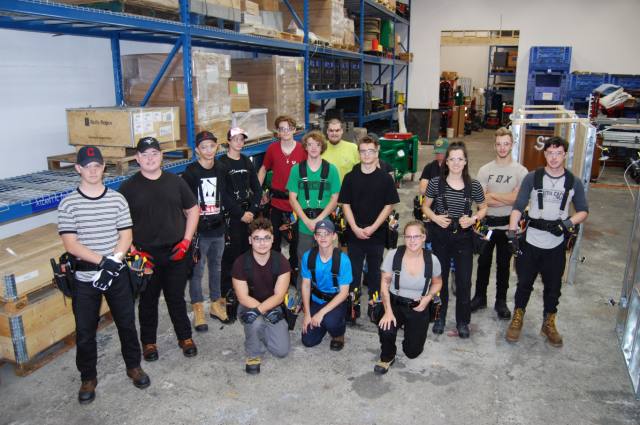WATT
YOUR BRIDGE TO A CAREER IN THE ELECTRICAL FIELD

Workplace Alternative Trades Training (WATT)
So, you’re interested in pursuing a career in the electrical field but lack training and experience? Ready to skip Foundations and get to work? Perhaps the Workplace Alternative Trades Training Program (WATT) is a good option for you!
WATT is an employer-verified, demand-driven, Electrical Pre-Apprenticeship Training program designed to remove apprenticeship barriers and increase completion rates among under-represented groups in the skilled trades.
Traditional pathways to apprenticeship are inaccessible to many, whether due to financial strain or prerequisite requirements. To meet unprecedented labour market demand, the IBEW, Western Joint Electrical Training Society (WJETS), and the Construction Foundation of BC came together and created WATT: a lower barrier, hands-on training program resulting in the ability to skip a Foundations Program, become an IBEW-sponsored apprentice and immediately enter into employment to get real experience as an electrical apprentice before starting level 1 of their technical training.
- Fewer barriers to apprenticeship
- Individualized support
- More hands-on training
- Higher rates of success
- Real experience in the trade prior to commitment to a career
- Union benefits
This fast-track pathway to a career in the Electrical Trade is best suited to people who work well under pressure, learn quickly and are highly motivated. Logical thinkers who are comfortable learning from their mistakes will do well. The minimum requirements to participate in WATT include:
- Be a minimum of 17 years-old (some opportunities may be limited to those 18+ due to select General Contractor requirements)
- Be a Canadian Citizen or Permanent Resident (Note: applications from those with Temporary Work Permits will be deleted)
- Hold a valid Drivers’ License (Class 5 or 7)
- Be living and settled in an active dispatch region (see next section)
Preferred qualifications and skills (leading to higher ranking) include:
- Having access to a vehicle or reliable transportation (public transportation typically not valid due to limited hours and service areas)
- Knowledge and ability to meet expectations as outlined
- Planning skills to navigate unforseen circumstances
- Demonstrated ability to acquire the necessary skills and attributes for successful apprenticeship in a limited amount of time
Construction work can be quite inconsistent. Depending on where you live, and what trade you work in, there may be sustained demand or unpredictable and periodic demand for your skillset. Currently IBEW Contractors are looking for new apprentices in the Active Dispatch Region(s):
- Victoria, BC and The Capital Regional District – 2+ ‘Gateway Assessments’ monthly
- Duncan
- Nanaimo
- Prince George – Next Gateway Assessment Thursday, March 13th!
- Williams Lake (early 2025)
- Dawson Creek (early 2025)
- The Kootenays (early 2025)
Note: Other areas with high labour market demand will be added here as applicable. Check in with your IBEW Local Union, and check this website frequently!- IBEW LU 230: Vancouver Island and Gulf Islands
- IBEW LU 993: Northern BC and Yukon
- IBEW LU 1003: Kootenays
If you submit an application, you will only be contacted when there is an upcoming assessment in your area.
WATT has a 96% apprenticeship continuation rate because we set people up for success. You will only be invited to attend in-shop training if:
- There is reasonable labour market demand in your area to support your long-term employment
- You have the readiness and skills needed to succeed on this fast-track pathway (as determined in your assessment)
- All other supports are in place to lead to your success (you may be eligible for certain supports depending on your ‘equity status’ or membership to certain equity groups.
Please enquire with your local IBEW Union with regard to upcoming work and WATT assessments:
- IBEW LU 230: Vancouver Island and Gulf Islands
- IBEW LU 993: Northern BC and Yukon
- IBEW LU 1003: Kootenays
If you submit an application, you will only be contacted when there is an upcoming assessment.
Yes, and it can vary based on your personal circumstances. The WATT Training wait times depend on four factors:
1. Perceived apprenticeship readiness (as determined by the Gateway Assessment)
2. Local labour market demand (we’re very careful not to oversaturate the market with new apprentices in areas where work is much more intermittent)
3. Your demographics (funding is often limited to certain equity-priority groups)
4. Our current funding
Currently WATT has (federal) funding for Women and (provincial) funding for people who identify as: Indigenous, Newcomers (immigrated in the last 5 years), Racialized Minorities (People of Colour), and/or 2SLGBTQIA+ applicants.
Previously the funding was much broader, and we’re constantly working on getting more funding to be more inclusive of all applicants who could benefit from this pathway. Keep checking back as we’re constantly applying for new funding so this could change in the near future.
If you don’t identify as belonging to any of these groups, you can still ask to be invited to Exploratory Gateway Training (the WATT assessment) so we can help guide you to the pathway that might be best for you! To request an assessment, continue to the application at the bottom of this page!
The main assessment criterion is “apprenticeship readiness”. Yes, you can apply BUT you will need to understand that not having a valid drivers license or access to a reliable vehicle will severely limit your employment options. Applicants are ranked on their apprenticeship readiness and not having a vehicle/license will certainly impact your position on the list.
- Often in this industry you can be on one site one day, and have less than 12h notice before you’re expected to be on another site (possibly on the other side of the city with limited to no access to public transit)
- Public transit schedules typically don’t align well with construction hours outside of major routes
- Public transit schedules change and often do not run on time, putting you at risk of layoff in an industry with zero tolerance for tardiness
- Other modes of transportation (e.g. Bicycle) may be considered acceptable, however you must consider the weight of your tools (50lbs) and lack of appropriate changeroom facilities on most sites
- At minimum, on most sites you must have a valid license as apprentices are often tasked with driving the company vehicle as a daily job requirement
- WATT Candidates are chosen when and where new apprentices are needed most. To be considered for training, we must determine if WATT is the right pathway for you. There are several steps to this process: The first step is an instructor-led practical assessment where you will be asked to wire up a circuit containing multiple switches, plugs, and a light. Note: you are not expected to walk in having any electrical knowledge or experience. You are expected to:
- Show up 15 minutes early;
- Participate with a great attitude;
- Ask questions when you need clarification;
- Pay attention to detail; and
- Show a high level of motivation to learn and improve.
- The second assessment is an academic assessment (English Reading Comprehension and Algebra). NOTE: In some cases, the academic assessment may be delayed due to scheduling constraints.
These steps are not graded as pass/fail but instead help the WATT team better understand where you may have academic gaps or challenges and how we can support you through your learning as a low-term electrical apprentice. Sometimes participants need a little help before starting the program, or if they are able and committed to brushing up their skills, we can arrange for academic support while in apprenticeship.
The WATT team will make notes on your readiness for apprenticeship and individual circumstances. Your application will be ranked and top applicants may be asked to participate in an interview.
WATT Interview
The top ranked applicants who meet the current selection criteria (location, apprenticeship readiness & demographics related to funding constraints) will be invited to participate in an interview with the Construction Foundation of BC. If you are selected for an interview, you will hear within 5 business days. If we determine that WATT isn’t the right pathway for you, you will be notified (also within 5 business days).
Due to the volume of applications received, kindly note that candidates will only be contacted when there is an opportunity to proceed in the selection process. If you do not get notified of an interview within 5 business days, you are on the wait list.
Those who do not meet the current selection criteria (or maybe need a little more time to succeed) will remain on the list for consideration for participation in future cohorts. Unfortunately, Admin staff cannot provide feedback. All relevant feedback on your performance will be given to you by the instructor at the practical assessment. There will be no opportunity to be reassessed for higher ranking.
If you wish to withdraw your application at anytime, please email emilie@wjets.ca
WATT Online Pre-Requisite (2 weeks – Part-Time)
If you complete the practical assessment and interview, are recommended for the program, and you wish to proceed, you will be registered for the Pre-WATT online learning module. This is a two-week pre-requisite course where you will learn more about the program and expectations, some basic electrical theory, develop some tool literacy, and complete several safety certifications. In total, this online course is approximately 3-4 full days’ work which can typically be completed by dedicating a few hours each day over the two-week period, plus perhaps a couple weekend days.
NOTE: Registration in the online pre-requisite course is not a guarantee for selection for the in-shop training. Candidates must consider this step as part of their interview process and successfully complete the online course.
WATT In-Shop Training (2.5 Weeks – Full-Time)
After completing the online learning module, in-shop training is the next step. This is scheduled in accordance with labour market demand. Once there is demand for new apprentices in your area, WATT Program staff will select from those who have successfully completed the online learning module to participate in a full-time, 2 ½ week in-person training program designed to prepare you for beginning your new career with the IBEW.
Upon successful completion of the in-shop training, you will apply for membership and be classified as a ‘Permit’ with the IBEW, which means you’re ready for dispatch as a “pre-apprentice”. Your name will go on the dispatch list and you will be eligible to work for a union signatory contractor.
The wait time for dispatch can depend on location and unforeseen changes in market demand, so although not common, it is always a good idea to have a plan B: Be prepared to sit on the dispatch list for a couple of months awaiting your first dispatch.The starting wage for a brand new “pre-apprentice” working on a commercial jobsite, is currently set at $24.33/hr. resulting in approximately $2,400-3,100/month (net, depending on hours per week) for the first 6 months of your apprenticeship. Apprentices are automatically bumped to the next pay rate (approximately 5% higher) after 6 months’ worked, in addition to scheduled wage increases.
Please note that the employment you will be dispatched to runs on a full-time schedule and, in turn, the IBEW requires that you have full-time availability and a reliable mode of transportation (including backup plans in case of inclement weather, etc.) when agreeing to a dispatch. As the beginning of any apprenticeship is a highly labour-intensive experience, please be aware that there may be some physical discomfort and a sharp learning curve when transitioning into this line of work.
Paying dues is like paying premiums on an insurance policy – where you don’t have to die to have it pay off. You collect the benefits everyday of your working life.
https://ibewyes.org/know-your-rights/
Unions are a voice
When workers come together as one group, they give themselves a voice in the workplace—just like management has—through wages, benefits, and rules guaranteed by a collective agreement. Without a union and a contract, your rights on the job can be overlooked and your working conditions can be changed simply at the whim of management (reduced wages and lack of fair compensation for overtime.)
Job Security
Unions offer a wide range of opportunities and benefits to workers–at work, and in their personal lives. Increased work-life-balance leads to a better way of life.
Safety
The IBEW was founded through tragedy. In the late 1800s, when public demand for electricity surged, electrical workers put their lives at risk daily and often died on the job. Workers came together, forming the IBEW to ensure that they could go home to their families at night by enacting training and revolutionary safety standards and procedures. Still today, the IBEW holds its Union Contractors to the highest standards and ensures that workers have the necessary training to work safely.
Even with modern provincial regulations on construction sites today, the IBEW goes above and beyond in members’ best interest. This holds true for emotional safety and access to mental health care, as well as leading Diversity, Equity and Inclusion (DEI) with the highest percentages of equity-deserving workers of anyone else in the industry. With zero tolerance for harassment or unprofessional behaviour of any sort, your local union stands with you, advocating for your rights and stays accountable to providing safe, respectful and inclusive workplaces.
Inclusivity
Do not be fooled by the name. The IBEW is much more than a ‘brotherhood’, promoting gender equity and upholding rights of all workers. As such, the organization is committed to actions. The IBEW by constitution is inclusive and continually practices respect for and appreciation of differences with ethnicity, gender, age, national origin, disability, sexual orientation and religion.
Solid Benefits
Through the bargaining power of over thirteen-thousand members, the IBEW (in BC) enjoys 100% employer-paid health and welfare benefits that offer more than any other plan. Holiday and Stat pay, currently at 12% rather than the standard 8%, and an industry leading pension are a few more reasons to join the IBEW.
Accessible, High-Quality Training
Both on the job and off, union members have access to better training. The greater variety of union employment opportunities results in better trained professionals. Union members earn more because they are worth more. Staying at the leading edge of industry, IBEW members also have access to innovative, quality training at no additional cost. Industry is ever-changing and members access the best professional development opportunities to stay on top. For information on upgrade training available to members of locals 230, 993 & 1003 refer to www.wjets.ca
Better Pay
While the competition may offer slightly higher wages to new apprentices, they cannot compete with the IBEW total wage package (including benefits mentioned above). IBEW also ensures that overtime (at 1.5 or 2x as required per the Collective Agreement) is paid. Non-union contractors certainly do not offer the regular (5%) increases or ‘term changes’ that IBEW apprentices are scheduled to receive every 6-months as per the Collective Agreement. Or the 20% compounded increases to the IBEW’s Construction Wage increases set in place until 2026.
Thanks to the generous funding of our partners including, the Government of Canada and the Province of British Columbia (SkilledTradesBC), the program is free and there may even be certain financial supports available to help you cover some bills while you’re in training. But you will not be paid wages while you’re in training, and you will need to take 2.5 weeks off work to complete the in-shop portion.
The nice thing about apprenticeships is that once you’re dispatched to an electrical contractor, you get paid to learn! IBEW apprentices on Commercial Jobs start at $24.33/h as of April 28, 2024 (other rates, higher or lower, may apply depending on availability and type of work in your area). As per the Inside Electrical Workers Collective agreement, this rate is scheduled to go up another 4.5% in 2025, in addition to the ~5% raise every 6 months worked that apprentices enjoy over and above the scheduled wage increases. The Journeyperson rate on Commercial Electrical sites is currently $48.66 (April 28, 2024). You can expect to be making over $117,000 year after 4 years (Gross, including extended medical benefits and RRSP/Pension contributions). Most apprentices can even collect EI while in school and there are many financial supports in the form of Scholarships, Bursaries, Grants and Tax Incentives for apprentices that make apprenticeship very lucrative.
It’s true! WATT is a great opportunity. If you’re selected (and successfully complete the program), you will save you a lot of time and money and get you on your way to earning your Red Seal as soon as possible. After WATT, you get to skip the Foundations program, get your apprenticeship sponsorship and get paid to learn. After approximately one year working, you will complete 10 weeks of block level training (Construction Electrician Level 1) and continue alternating between work and school for the next 3 years.
If you are fascinated by the growing field of electrical employment and the WATT program sounds like a good fit for you, please follow the four steps below to apply! Thank you for your interest in the WATT program! We hope to hear from you soon.
To apply for WATT, first review all 4 steps (below):
- After reviewing the steps below, you must read and agree to the WJETS Terms of Service Agreement.
Collection, Use and Disclosure Notice
As part of your participation in WJETS activities or services, personal information and data will be collected from you including but not limited to the information indicated above as well as contact, demographic and work history information.
All personal information gathered at Intake, Assessment or through Training and other information related to your participation in WJETS programs (“Personal Information”) is collected pursuant to sections 26(c), 26(e), and 27(1)(a)(i) of the Freedom of Information and Protection of Privacy Act. This information will be used for administrative, evaluation, program development, and /or research purposes, including to determine your eligibility for participation in the program.
Demographic and participation information related to program activities may be disclosed to the Province of British Columbia or the Government of Canada for the purposes of program administration, evaluation, and reporting.
Click the button below to confirm (NOTE: If you are under the age of 18, you will not be able to agree to the WJETS Terms of Service Agreement and you will need your guardian’s help with this step. Please email emilie@wjets.ca for more information):
2. Create an online learning account on Western Joint Electrical Training Society’s online learning platform, Moodle (or log in if you already have an account).
3. Enroll yourself in the course called WATT Application by clicking the Self enrolment icon:
4. Complete and submit the online WATT Participant Intake form. You will receive an email response from program staff with next steps. If you might currently be eligible for the program, or a partner has suggested you be assessed, you will be invited to attend a practical assessment.
Due to high volume of applications, and depending on current labour market demand in your area, you may be waiting up to a month for a response.








